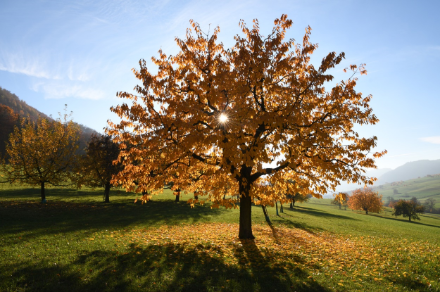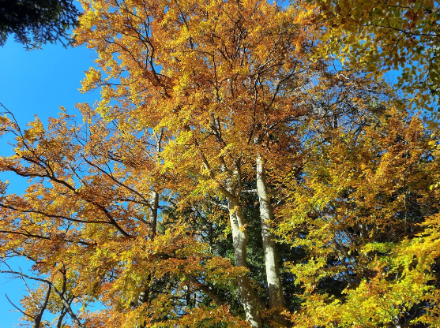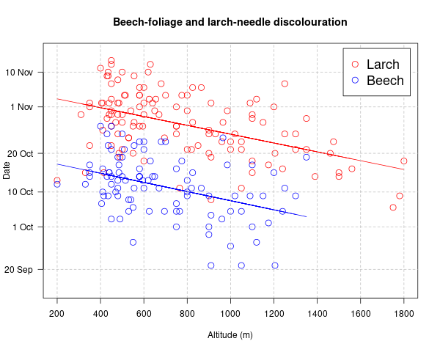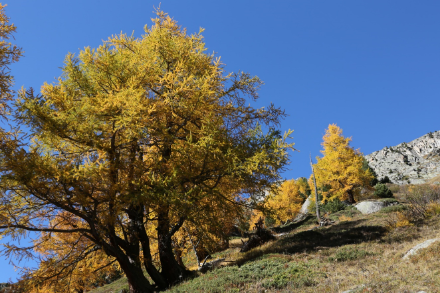Service Navigation
Search
Foliage discolouration is a sign that the trees are preparing for the cold season. The shorter days and cooler temperatures trigger an ageing process in the leaves whereby nutrients and chlorophyll – the green pigment responsible for photosynthesis in leaves – are broken down into their chemical components and stored in the trunk, branches, and roots.
Where do the autumn leaf colours come from?
After the green colour has disappeared from the leaves, colour pigments emerge that were hidden by the chlorophyll in spring and summer. Although these are also broken down in the autumn, this does not happen as quickly as with chlorophyll. The red pigment (anthocyanin) is produced in the leaves in autumn to protect the dormancy processes from overly intense sunlight. The brown colour only appears as the leaves begin to die.
A cork-like tissue forms between the leaf and the twig in autumn. The next strong gust of wind causes the leaves to fall to the ground, where they continue to decompose.
Each tree species has its own characteristic autumn hues. For example, larch, birch, lime and maple glow golden yellow. Beech trees display yellow, orange and brown-red hues. Reds are not as common on Switzerland's trees as they are, for example, in the oak and maple forests of the USA and Canada, famed for their spectacular displays of autumn colour. However, the intense reds do appear here on ornamental shrubs like the guelder rose, red dogwood and many others.

What factors affect the intensity of the autumn colours?
The intensity of the colours depends on the weather. Plenty of sun together with low temperatures without frost ensure that the chlorophyll is broken down very quickly while also enabling more red pigment to be produced. A spell of warm, sunny days with cool nights is what makes for the most spectacular colours in autumn. When there is minimal rain and wind, the autumnal colours last longer. On the other hand, early frosts and cold periods preclude an impressive autumnal display. Heavy rain and strong winds can cause the leaves to fall before they have had a chance to develop their most beautiful colours.

When can leaf discolouration be observed in Switzerland?
Autumn leaf colouration starts in the mountains and works its way down to the lowlands. An evaluation of the data from phenology monitoring stations between 1991 and 2020 shows that the discolouration of beech foliage and larch needles works its way down to the lowlands at a rate of 1.1 days per 100 metres of altitude. However, the observations demonstrate a large amount of variation. In other words, leaf discolouration can also be observed early on in the lowlands as well as later on at higher altitudes, depending on the location and tree species. Widespread beech-foliage discolouration begins at the end of September at altitudes of over 1,000 m and in the first ten days of October in the lowlands.

The yellow larch forests in the Engadine and Valais are particularly impressive. On average, larches at altitudes above 1,500 m change colour around mid-October. At the lowest altitudes, it is only towards the end of October and beginning of November that the needles change colour. However, there are significant variations in these timings from year to year. The earliest needle discolouration occurred in St. Moritz on 6 October 2007, and the latest on 24 October 2020.

What factors influence the timing of leaf discolouration?
The timing of leaf discolouration is influenced by several factors, not all of which are precisely understood. When the days become shorter, this triggers the breakdown of chlorophyll and consequently the emergence of the yellow and red pigments. Temperature and dryness also play a role in this process. Delayed leaf discolouration occurs when the months of August and September are very warm. A cool September usually leads to early leaf discolouration. A very warm, dry late spring and early summer can also bring leaf discolouration forward. In addition, the trees' level of productivity during the growing season also seems to play a role: The faster and stronger the trees grow in spring and summer, the earlier leaf discolouration occurs.
The temperature increase that has occurred since the beginning of phenological observations in 1951 has varying impacts on leaf discolouration. At low altitudes in Switzerland, beech trees are now changing colour almost five days later than they did in 1951, whereas in the mountains the discolouration is starting a few days earlier. It is therefore difficult to predict how the timing of leaf discolouration will evolve in the future with climate change. The contributing factors are still not well understood.